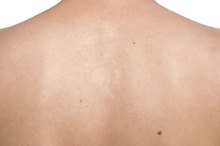What does fact checked mean?
At Healthfully, we strive to deliver objective content that is accurate and up-to-date. Our team periodically reviews articles in order to ensure content quality. The sources cited below consist of evidence from peer-reviewed journals, prominent medical organizations, academic associations, and government data.
The information contained on this site is for informational purposes only, and should not be used as a substitute for the advice of a professional health care provider. Please check with the appropriate physician regarding health questions and concerns. Although we strive to deliver accurate and up-to-date information, no guarantee to that effect is made.
Red Blemishes on the Back & Arms After Yard Work
Whether you have a green thumb or not, doing yard work can expose you to a variety of plants, weeds and insects that can cause skin irritation, rashes and bites. Accurately identifying the cause of skin irritation can lead to a quick recovery and prevent it from happening again in the future.
Cause
The cause of red blemishes on the back and arms after yard work can differ, based on the type of yard work that you did as well as your geographical location. Native plants, weeds and insects vary widely, depending on landscape and climate. Irritation on your back and arms could be caused by physical contact with branches, leaves or brush. Plants with thorns or thistles can be especially dangerous. According to SkinCarePhysicians.com, exposure to poison ivy, poison oak and poison sumac can cause allergic contact dermatitis, a type of eczema 13. Insect bites can include mosquitoes, ticks, spiders, bees and wasps to name a few.
- The cause of red blemishes on the back and arms after yard work can differ, based on the type of yard work that you did as well as your geographical location.
- Irritation on your back and arms could be caused by physical contact with branches, leaves or brush.
Signs and Symptoms
What Is the Difference Between Cellulitis & Mrsa?
Learn More
Your back and arms may appear scratched if your skin came in contact with sharp branches, and it is unlikely that there is a regular pattern to the irritation. Signs and symptoms of allergic contact dermatitis include itchy, red and swollen skin or dry and bumpy skin and blisters, if the reaction is severe. Insect bites vary in appearance, based on the type of insect that bit you.
Treatment
Check to make sure there are no thorns and thistles embedded in your skin. You may want to use tweezers if you are unable to remove them with your fingers. Wash any scratches or open areas with lukewarm water and mild soap. You may want to apply antibiotic ointment to them and cover them with adhesive bandages to prevent infection.
- Check to make sure there are no thorns and thistles embedded in your skin.
- You may want to apply antibiotic ointment to them and cover them with adhesive bandages to prevent infection.
Prevention
What Is the Difference Between Cellulitis & Mrsa?
Learn More
Sufficient clothing may be the easiest and most effective protection against skin irritation while doing yard work. While it may be uncomfortable to wear long sleeves when it is warm outside, even a thin layer can protect your skin. Wear work gloves as your hands may be the most vulnerable to injury and irritation. Apply sunscreen to any exposed areas of skin and reapply as directed. Use insect repellent to decrease your chances of being bitten. Taking a cold shower can cleanse your skin of irritants.
- Sufficient clothing may be the easiest and most effective protection against skin irritation while doing yard work.
- Wear work gloves as your hands may be the most vulnerable to injury and irritation.
Considerations
Most red blemishes on the back and arms should resolve on their own within a few days after doing yard work. However, if the blemishes get worse or spread, you should see a dermatologist to see if additional treatment is required. According to MayoClinic.com, if you notice a bull's-eye type rash anywhere on your body, see a doctor as soon as possible as this could be a symptom of Lyme disease 23. Lyme disease is prevalent in heavily wooded areas and is caused by the bite of a deer tick 2. It requires antibiotic treatment and -- the sooner you seek treatment -- the better the outcome.
- Most red blemishes on the back and arms should resolve on their own within a few days after doing yard work.
- According to MayoClinic.com, if you notice a bull's-eye type rash anywhere on your body, see a doctor as soon as possible as this could be a symptom of Lyme disease 2.
Related Articles
References
Writer Bio
Currently residing in Livingston, Montana, Stephanie Berger is a Registered Nurse with a passion for preventative health. Since Berger began writing professionally in 2004, her work has appeared in "Women's World" magazine and "Forward in Christ" magazine. She holds a Bachelor of Science in nursing and a minor in Spanish for the health professions from Marquette University.








